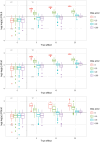Ecological Predictors of Organelle Genome Evolution: Phylogenetic Correlations with Taxonomically Broad, Sparse, Unsystematized Data
- PMID: 38459872
- PMCID: PMC11282362
- DOI: 10.1093/sysbio/syae009
Ecological Predictors of Organelle Genome Evolution: Phylogenetic Correlations with Taxonomically Broad, Sparse, Unsystematized Data
Abstract
Comparative analysis of variables across phylogenetically linked observations can reveal mechanisms and insights in evolutionary biology. As the taxonomic breadth of the sample of interest increases, challenges of data sparsity, poor phylogenetic resolution, and complicated evolutionary dynamics emerge. Here, we investigate a cross-eukaryotic question where all these problems exist: which organismal ecology features are correlated with gene retention in mitochondrial and chloroplast DNA (organelle DNA or oDNA). Through a wide palette of synthetic control studies, we first characterize the specificity and sensitivity of a collection of parametric and non-parametric phylogenetic comparative approaches to identify relationships in the face of such sparse and awkward datasets. This analysis is not directly focused on oDNA, and so provides generalizable insights into comparative approaches with challenging data. We then combine and curate ecological data coupled to oDNA genome information across eukaryotes, including a new semi-automated approach for gathering data on organismal traits from less systematized open-access resources including encyclopedia articles on species and taxa. The curation process also involved resolving several issues with existing datasets, including enforcing the clade-specificity of several ecological features and fixing incorrect annotations. Combining this unique dataset with our benchmarked comparative approaches, we confirm support for several known links between organismal ecology and organelle gene retention, identify several previously unidentified relationships constituting possible ecological contributors to oDNA genome evolution, and provide support for a recently hypothesized link between environmental demand and oDNA retention. We, with caution, discuss the implications of these findings for organelle evolution and of this pipeline for broad comparative analyses in other fields.
Keywords: Comparative methods; ecology; mtDNA; organelle evolution; phylogenetic generalized linear model; phylogenetic linear model; ptDNA.
© The Author(s) 2024. Published by Oxford University Press on behalf of the Society of Systematic Biologists.
Figures





Similar articles
-
Evolutionary inference across eukaryotes identifies universal features shaping organelle gene retention.Cell Syst. 2022 Nov 16;13(11):874-884.e5. doi: 10.1016/j.cels.2022.08.007. Epub 2022 Sep 16. Cell Syst. 2022. PMID: 36115336
-
Avoiding organelle mutational meltdown across eukaryotes with or without a germline bottleneck.PLoS Biol. 2021 Apr 23;19(4):e3001153. doi: 10.1371/journal.pbio.3001153. eCollection 2021 Apr. PLoS Biol. 2021. PMID: 33891583 Free PMC article.
-
Cellular and environmental dynamics influence species-specific extents of organelle gene retention.Proc Biol Sci. 2023 Mar 8;290(1994):20222140. doi: 10.1098/rspb.2022.2140. Epub 2023 Mar 8. Proc Biol Sci. 2023. PMID: 36883279 Free PMC article.
-
Evolution of the mitochondrial genome: protist connections to animals, fungi and plants.Curr Opin Microbiol. 2004 Oct;7(5):528-34. doi: 10.1016/j.mib.2004.08.008. Curr Opin Microbiol. 2004. PMID: 15451509 Review.
-
A proper study for mankind: Analogies from the Papionin monkeys and their implications for human evolution.Am J Phys Anthropol. 2001;Suppl 33:177-204. doi: 10.1002/ajpa.10021. Am J Phys Anthropol. 2001. PMID: 11786995 Review.
Cited by
-
Evolution and maintenance of mtDNA gene content across eukaryotes.Biochem J. 2024 Aug 7;481(15):1015-1042. doi: 10.1042/BCJ20230415. Biochem J. 2024. PMID: 39101615 Free PMC article. Review.
-
Connecting Species-Specific Extents of Genome Reduction in Mitochondria and Plastids.Mol Biol Evol. 2024 Jun 1;41(6):msae097. doi: 10.1093/molbev/msae097. Mol Biol Evol. 2024. PMID: 38758976 Free PMC article.
-
The Nitroplast and Its Relatives Support a Universal Model of Features Predicting Gene Retention in Endosymbiont and Organelle Genomes.Genome Biol Evol. 2024 Jul 3;16(7):evae132. doi: 10.1093/gbe/evae132. Genome Biol Evol. 2024. PMID: 38900924 Free PMC article.
References
-
- Auguie B., Antonov A. 2017. gridExtra: miscellaneous functions for “Grid” graphics. R Package Version 2.3. Computer Software. Available from: https://cran.r-project.org/web/packages/gridExtra/.
-
- Bates D., Mächler M., Bolker B., Walker S. 2015. Fitting linear mixed-effects models using lme4. J. Stat. Softw. 67(October):1–48. doi:10.18637/jss.v067.i01 - DOI
MeSH terms
Grants and funding
LinkOut - more resources
Full Text Sources
Research Materials

